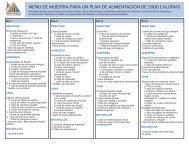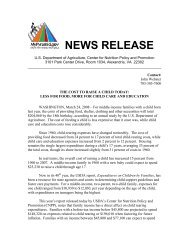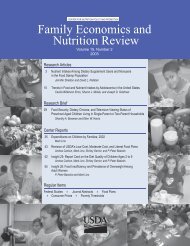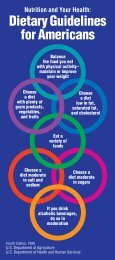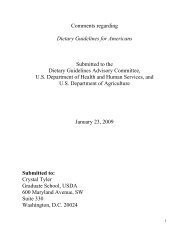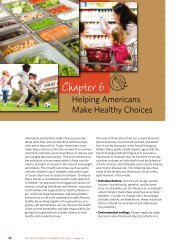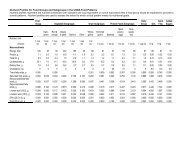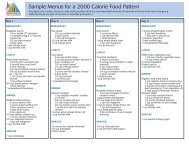Elderly Nutrition - Center for Nutrition Policy and Promotion - US ...
Elderly Nutrition - Center for Nutrition Policy and Promotion - US ...
Elderly Nutrition - Center for Nutrition Policy and Promotion - US ...
You also want an ePaper? Increase the reach of your titles
YUMPU automatically turns print PDFs into web optimized ePapers that Google loves.
Table 2. Pre-test <strong>and</strong> post-test computed Stages of Change <strong>for</strong> fruit- <strong>and</strong> vegetableeating<br />
behaviors of elderly participants<br />
Treatment group 1 Fruits Vegetables<br />
Stage of change Pre-test Post-test Pre-test Post-test<br />
Percent<br />
Maintenance 32 32 28 46<br />
Action 0 8 4 10<br />
Preparation 20 20 24 26<br />
Contemplation 4 8 0 0<br />
Precontemplation 24 28 30 12<br />
Cannot categorize 20 4 14 6<br />
Control group 2 Fruits Vegetables<br />
Stage of change Pre-test Post-test Pre-test Post-test<br />
Percent<br />
Maintenance 20 18 47 33<br />
Action 2 6 0 4<br />
Preparation 25 19 8 18<br />
Contemplation 2 4 2 2<br />
Precontemplation 43 49 33 33<br />
Cannot categorize 8 4 10 10<br />
Our findings indicate that the<br />
HELP nutrition lessons made a<br />
difference . . . in how some older<br />
adults in the treatment group<br />
thought about changes, planned<br />
<strong>for</strong> changes, or made changes in<br />
their fruit- <strong>and</strong> vegetable-eating<br />
behaviors.<br />
1 n = 50.<br />
2 n = 51.<br />
others planned to take action during<br />
the next month to change their<br />
vegetable-eating behavior. At the posttest,<br />
members of the treatment group<br />
most frequently characterized their<br />
vegetable-eating behavior as being<br />
related to Maintenance, followed by<br />
Preparation, <strong>and</strong> Precontemplation<br />
(46, 26, <strong>and</strong> 12 percent, respectively), a<br />
different pattern than was the case at<br />
the pre-test phase. The control group’s<br />
responses at pre-test were mostly in<br />
two categories: Maintenance (47<br />
percent) <strong>and</strong> Precontemplation (33<br />
percent). The post-test category <strong>for</strong><br />
Precontemplation remained at 33<br />
percent, but the Preparation category<br />
was 18 percent, a change from the pretest<br />
(8 percent). Also, control group<br />
participants categorizing their behavior<br />
as Maintenance dropped to 33 percent<br />
at the post-test phase.<br />
Results from the sign tests revealed no<br />
significant difference between pre-test<br />
<strong>and</strong> post-test results <strong>for</strong> neither the<br />
treatment group nor the control group<br />
<strong>for</strong> stage of change related to fruiteating<br />
behaviors nor <strong>for</strong> the control<br />
group <strong>for</strong> stage of change related to<br />
vegetable-eating behaviors (table 3).<br />
However, a significant positive change<br />
<strong>for</strong> stage of change <strong>for</strong> the treatment<br />
group’s vegetable-eating behaviors<br />
existed. This positive change shows<br />
movement from a lower stage of change<br />
category to a higher category from the<br />
pre-test to the post-test.<br />
Limitations of the Study<br />
Findings were limited to the older<br />
adults in this study. Participants were<br />
not r<strong>and</strong>omly selected because they<br />
were attendees of pre-arranged class<br />
sites, <strong>and</strong> some self-selection occurred.<br />
2003 Vol. 15 No. 1 21



